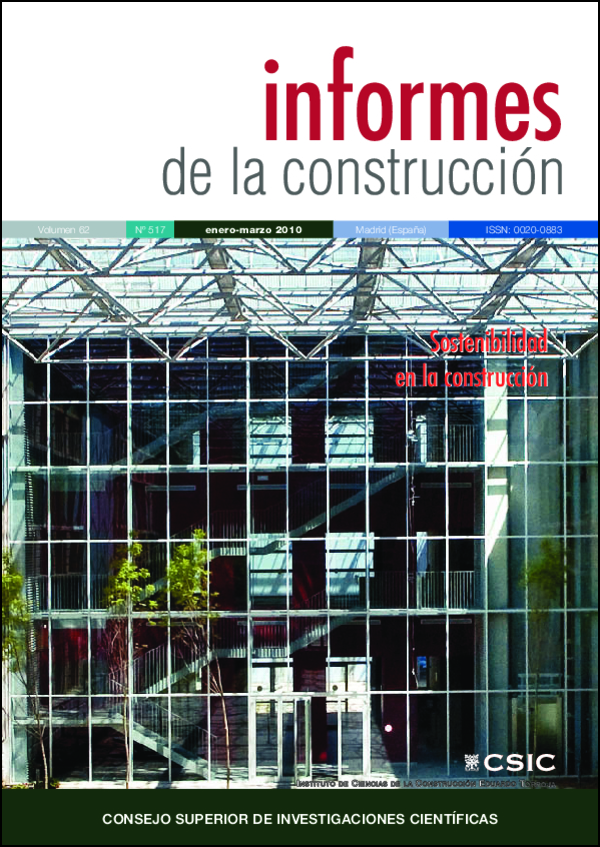VERDE, a methodology and tool for a sustainable building assessment
DOI:
https://doi.org/10.3989/ic.08.056Keywords:
sustainable buildings, impact categories criteria, sustainable indicators, environmental assessmentAbstract
Sustainable Building has grown out of a synthesis of the environmentally-oriented Green Building movement and the broader SD movement. The green movement itself grew out of 1970’s concerns about Energy Conservation, which subsequently morphed into Energy Efficiency, as fuel prices declined during the 1980’s. During the 1980’s, energy issues receded somewhat into the background of general discussion, but concerns arose about the impact that building operations and the production of their constituent materials have on the natural environment. During the same decade, the issue of poor indoor air quality and inadequate ventilation in sealed buildings (“sick building syndrome”) became a very public concern. A consensus has gradually evolved concerning the type of issues that should be included within a green type of analysis. Since 2000 the number of environmental assessment methodologies around the world has been increasing rapidly. BREEAM (BRE Environmental Assessment Method) was the first system (launched in 1990), to offer an environmental label for buildings. Nevertheless, LEED (Leadership in Energy and Environmental Design) has been an incontrovertible success as a tool to promote market transformation. There are a number of different schemes around the world, most of which have been based on GBC and iiSBE (International Initiative for a Sustainable Built Environment). A new assessment method based on impact reduction calculation has been developed. The tool call VERDE is applicable to commercial complexes and residential developments. The methodology are presented and discussed in the paper.
Downloads
References
(1) Thomas Saunders. A discussion document comparing International environmental assessment methods for buildings. BRE, March 2008.
(2) Zhuguo Li. A new life cycle impact assessment approach for buildings. Building and Environment, 41 (2006) 1414–1422. doi:10.1016/j.buildenv.2005.05.034
(3) W.L. Lee, F.W.H. Yik, J. Burnett. Assessing energy performance in the latest versions of Hong Kong Building Environmental Assessment Method (HK-BEAM). Energy and Buildings, 39 (2007) 343–354. doi:10.1016/j.enbuild.2006.08.003
(4) ISO/FDIS 15392 Sustainability in building construction - General Principles.
(5) ISO/TS 21929 Sustainability in building construction - Sustainability indicators- Part 1: Framework for the development of indicators for buildings.
(6) ISO 21930 Sustainability in building construction - Environmental declaration of building products.
(7) prEN 15643-1 Sustainability of construction works - Integrated assessment of building performance. Part 1: General framework.
(8) prEN 15643-2 Sustainability of construction works - Assessment of buildings — Part 2: Framework for the assessment of the environmental performance.
(9) prEN 15643-3 Sustainability of construction works - Integrated assessment of building performance. Part 3: Framework for the assessment of social performance.
(10) prEN 15643-4 Sustainability of construction works - Integrated assessment of building performance. Part 4: Framework for the assessment of economic performance.
(11) WI 3500011 Sustainability of construction works - Assessment of environmental performance of buildings - Calculation methods.
(12) prEN 15804 Sustainability of construction works - Environmental product declarations - Product Category Rules.
(13) Indicadores ambientales. Una propuesta para España, Ministerio de Medioambiente, Madrid, 1996.
(14) Perfil ambiental de España 2006, Ministerio de Medioambiente, 2007.
Downloads
Published
How to Cite
Issue
Section
License
Copyright (c) 2010 Consejo Superior de Investigaciones Científicas (CSIC)

This work is licensed under a Creative Commons Attribution 4.0 International License.
© CSIC. Manuscripts published in both the print and online versions of this journal are the property of the Consejo Superior de Investigaciones Científicas, and quoting this source is a requirement for any partial or full reproduction.
All contents of this electronic edition, except where otherwise noted, are distributed under a Creative Commons Attribution 4.0 International (CC BY 4.0) licence. You may read the basic information and the legal text of the licence. The indication of the CC BY 4.0 licence must be expressly stated in this way when necessary.
Self-archiving in repositories, personal webpages or similar, of any version other than the final version of the work produced by the publisher, is not allowed.















